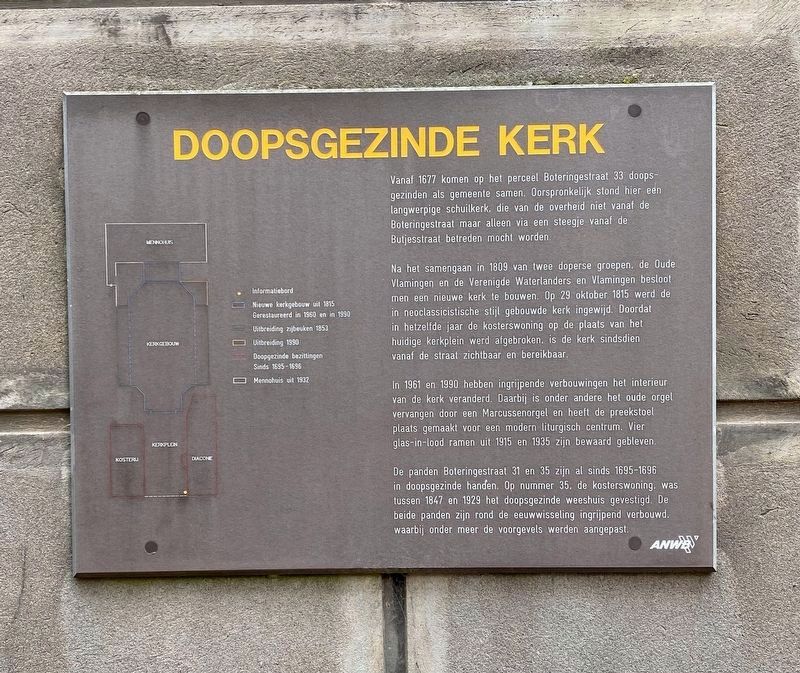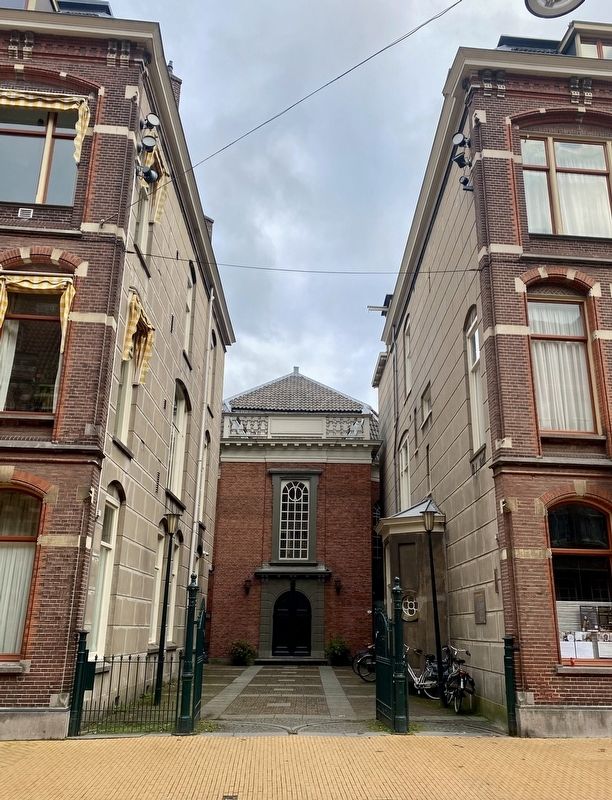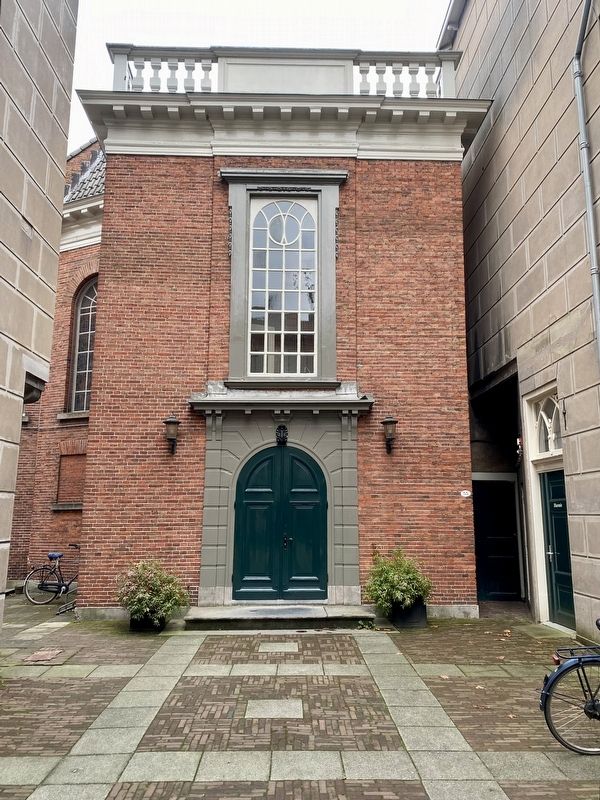Groningen, Netherlands — Northwestern Europe
Doopsgezinde Kerk / Mennonite Church
Inscription.
Vanaf 1677 komen op het perceel Boteringestraat 33 doopsgezinden als gemeente samen. Oorspronkelijk stond hier een langwerpige schuilkerk, die van de overheid niet vanaf de Boteringestraat maar alleen via een steegje vanaf de Butjesstraat betreden mocht worden.
Na het samengaan in 1809 van twee doperse groepen, de Oude Vlamingen en de Verenigde Waterlanders en Vlamingen besloot men een nieuwe kerk te bouwen. Op 29 oktober 1815 werd de in neoclassicistische stijl gebouwde kerk ingewijd. Doordat in hetzelfde jaar de kosterswoning op de plaats van het huidige kerkplein werd afgebroken, is de kerk sindsdien vanaf de straat zichtbaar en bereikbaar.
In 1961 en 1990 hebben ingrijpende verbouwingen het interieur. van de kerk veranderd. Daarbij is onder andere het oude orgel vervangen door een Marcussenorgel en heeft de preekstoel plaats gemaakt voor een modern liturgisch centrum. Vier glas-in-lood ramen uit 1915 en 1935 zijn bewaard gebleven.
De panden Boteringestraat 31 en 35 zijn al sinds 1695-1696 in doopsgezinde handen. Op nummer 35, de kosterswoning, was tussen 1847 en 1929 het doopsgezinde weeshuis gevestigd. De beide panden zijn rond de eeuwwisseling ingrijpend verbouwd, waarbij onder meer de voorgevels werden aangepast.
From 1677 on, Mennonites have been assembling as a congregation on the Boteringestraat 33 parcel. Originally there was an elongated hidden church here, which the government did not allow to be entered from the Boteringestraat, but only via an alley from the Butjesstraat.
After the merger in 1809 of two Mennonite groups, the Old Flemings and the United Waterlanders and Flemings, it was decided to build a new church. On October 29, 1815, the church, built in neoclassical style, was inaugurated. Because the sexton's house on the site of the current church square was demolished in the same year, the church has been visible and accessible from the street ever since.
In 1961 and 1990, major renovations changed the interior of the church. Among other things, the old organ was replaced by a Marcussen organ and the pulpit was replaced by a modern liturgical center. Four stained glass windows from 1915 and 1935 have been preserved.
The Boteringestraat 31 and 35 buildings have been in Mennonite hands since 1695-1696. Between 1847 and 1929, at number 35, the sexton’s house, the Mennonite orphanage was located. Both buildings were extensively renovated around the
turn of the century, including changes to the facades.
Erected by The ANWB.
Topics. This historical marker is listed in this topic list: Churches & Religion. A significant historical date for this entry is October 29, 1815.
Location. 53° 13.189′ N, 6° 33.851′ E. Marker is in Groningen. Marker is on Oude Boteringestraat, on the right when traveling north. Touch for map. Marker is at or near this postal address: Oude Boteringestraat 33, Groningen 9712 GP, Netherlands. Touch for directions.
Other nearby markers. At least 8 other markers are within walking distance of this marker. Oude Boteringestraat 36-38 (a few steps from this marker); Huis met de Dertien Tempels / House with the Thirteen Temples (within shouting distance of this marker); Oude Boteringestraat 44 (within shouting distance of this marker); Oude Boteringestraat 52 (about 90 meters away, measured in a direct line); Oude Ebbingstraat 39 (about 180 meters away); Het Soephuis / The Soup House (about 180 meters away); Chez Dicque (about 180 meters away); Goudkantoor (about 210 meters away). Touch for a list and map of all markers in Groningen.
Regarding Doopsgezinde Kerk / Mennonite Church. Since the early beginnings of the Protestant Reformation the city of Groningen has hosted a faith-community practicing Mennonite beliefs. Church-State structures did not tolerate these Anabaptists or "Anabaptizers," meaning re-baptizers. Over the course of two generations, thousands were persecuted. Many met death as martyrs. In order to preserve the movement, the survivors went into hiding. Gatherings took place in private homes. Since 1677 a Mennonite congregation gathered in a house that was located just in front of the actual church. In 1809 different Mennonite congregations reunited and erected the current church building. The house in front was then torn down. The church continued to outgrow its facilities and several additions to the building were made until the building reached its present dimensions and became equipped with a pipe organ, built in 1961 by the famous Danish organ building firm Marcussen. Inside the church, one can admire a contemporary piece of art created in 1991 by the Groninger artist, Jan Steen.
Also see . . . Mennonite Church in the Netherlands. Wikipedia entry (Submitted on July 18, 2023, by Larry Gertner of New York, New York.)
Credits. This page was last revised on December 31, 2023. It was originally submitted on January 25, 2023, by Andrew Ruppenstein of Lamorinda, California. This page has been viewed 61 times since then and 16 times this year. Photos: 1, 2, 3. submitted on January 25, 2023, by Andrew Ruppenstein of Lamorinda, California.


